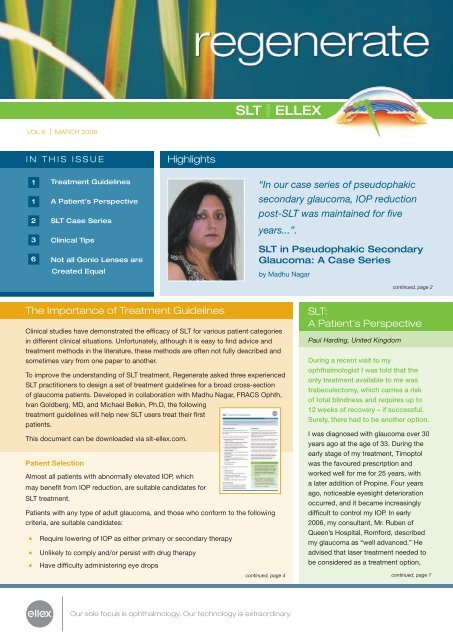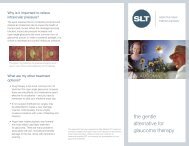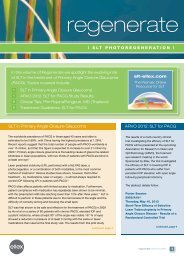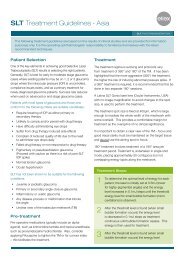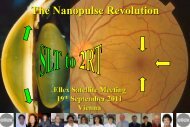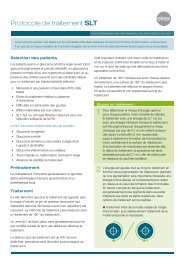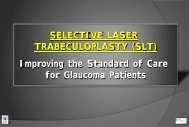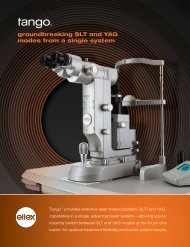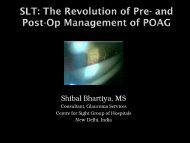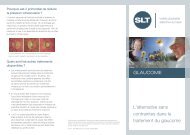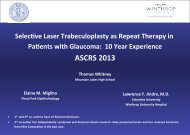Regenerate - SLT for Glaucoma | Ellex
Regenerate - SLT for Glaucoma | Ellex
Regenerate - SLT for Glaucoma | Ellex
- No tags were found...
Create successful ePaper yourself
Turn your PDF publications into a flip-book with our unique Google optimized e-Paper software.
Not All Gonio Lenses are Created EqualMichael Belkin, MA, MD, Professor of Ophthalmology at Tel Aviv University<strong>SLT</strong> effectively reduces IOP bya process that, as yet, is notcompletely understood. What isknown is that this reduction isinitiated by the application of laserenergy, deflected by the gonio lensonto the trabecular meshwork (TM).There is a direct relationship betweenthe amount of energy imparted to theTM cells and the extent to which IOPis lowered.What has not been firmly established is the exact doseresponserelationship between the amount of energy used perlaser application, and the subsequent IOP-lowering effect. Thedifficulty in computing this is compounded by the fact thatgonio lenses differ markedly in the extent to which they magnifythe image of the anterior chamber angle. The following tableillustrates the differing magnification factor of gonio lensescurrently available:Table 1:With a reduced <strong>SLT</strong> treatment spot size, the energy appliedmust be decreased in order to maintain <strong>SLT</strong>’s extremely-lowenergy fluence of 6 mJ/mm 2 (compared to ALT’s fluence of40,000 mJ/mm 2 ). For instance, using a non-magnificationlens (recommended <strong>for</strong> <strong>SLT</strong> treatment) set at 1 mJ energysetting produces <strong>SLT</strong>’s 400 micron spot size with a fluence of7.96 mJ/mm².Using a lens with a magnification factor of 1.5 produces a 268micron laser treatment spot. Consequently, to achieve the sameenergy fluence as with a non-magnification lens (7.96 mJ/mm²),the energy setting should be set at 0.45 mJ. This precautionis particularly important in heavily pigmented angles and mayexplain the unusual incidence of pressure spikes that have beennoted after treating such angles with <strong>SLT</strong>.Furthermore, the smaller treatment spot size induced bya magnifying gonio lens reduces the surface area treated,complicating the aiming and positioning of the laser beam onthe TM compared to the 400 micron spot size offered by a nonmagnificationlens.Latina <strong>SLT</strong>Gonio(Ocular)MagnaView(Ocular)ThreeMIrrorUniversal(Ocular)G-1Trabeulum(Volk)G-4Gonio(Volk)3 MIrror(Volk)360Gonio(Volk)CGAL(Haag-Streit)Lens TypesinglemirrorsinglemirrorGoldmann single mirror fourmirrornot avail. not avail. singlemirrorMaterial acrylic acrylic acrylic glass glass acrylic acrylic glassMirror Angle 63˚ 62˚ 59˚ 62˚ 4 x 64˚ 60˚ n/a˚ 58ContactDIameter14.5 mm 14.5 mm 18 mm 15 mm 8.4 mm 18 mm 14 mm 12 mmLens Height 24 mm 23.5 mm 32 mm not avail. not avail. not avail. not avail. 24 mmFOV 130˚ 160˚ 140˚ not avail. not avail. not avail. not avail. not avail.Image Mag. 1.0x 1.30x 0.93x 1.5x 1.0x 1.06x 1.5x 1.5xLaser SpotMag.<strong>SLT</strong> SpotSize1.0x 0.77x 1.08x 0.67x 1.0x 0.94x 0.67x 0.67x400 308 432 268 400 376 268 268As seen from the table, magnification of the various lensesvaries from 0.93 to 1.5, which means that the size of the lasertreatment spot on the TM varies accordingly; thus, the energyimparted per unit area also varies. As such, we can assume thatthe resultant IOP-lowering effect also varies.Source: <strong>Ellex</strong>Given that the <strong>SLT</strong> dose-response function is not yetdetermined, the effect of these various energy fluences atdifferent levels of magnification on the efficacy of <strong>SLT</strong> is notcompletely understood. This problem is mitigated, in part, bythe customary titration procedure of irradiating the TM untilcontinued, page 86regenerate March 2008
<strong>SLT</strong>: A Patient’s Perspective, continuedgiven that three sets of eye drops were nolonger controlling my IOP.Using the Internet, I researched glaucomalaser treatment and discovered bothargon laser trabeculoplasty (ALT) andthe comparatively new selective lasertrabeculoplasty (<strong>SLT</strong>). On reading all I couldfind, including in<strong>for</strong>mation from NHS Direct(health advice and in<strong>for</strong>mation serviceprovided by the National Health Service,England), I hoped to undergo <strong>SLT</strong> treatment.This was not going to be the case, asthe preferred treatment in the majority ofUK Hospitals is ALT. Mr. Ruben listenedto my request and agreed to refer me toMr. O’Brart at St Thomas’ Hospital, oneof the few UK hospitals where <strong>SLT</strong> isavailable. In August 2006 I saw a Mr. Limwho considered me unsuitable <strong>for</strong> <strong>SLT</strong>.Very disappointed with this news, I waspleased to find on a return visit to Mr.Ruben’s Clinic in October that my IOP waslow enough to remove the urgency <strong>for</strong> lasertreatment.Sadly, this was short lived. Furthertreatment became urgent in March 2007.Reluctantly, I received the ALT treatmentin May 2007. I was among the smallpercentage of patients who receive nobenefit from ALT; in fact, my pressureincreased slightly following the treatment.I felt very pessimistic about the situationand my future treatment options. As I hadarranged to take my wife away to celebrateher 60th birthday in late September, I wasprescribed Pilocarpine in addition to myother medications to pull the pressureunder control, with surgery scheduled <strong>for</strong>October.I was still very persistent that I should try <strong>SLT</strong>.Mr. Ruben kindly arranged a second referralto Mr. Ansari at Maidstone Hospital, Kent.On August 20, Mr. Ansari undertook adetailed assessment of myglaucoma, measuring the IOPin both eyes at 19mmHg. Tomy absolute joy, Mr. Ansariagreed to per<strong>for</strong>m <strong>SLT</strong> in earlySeptember.My <strong>SLT</strong> treatment commencedwith the addition of dropsto minimise any pressurespikes, followed by the<strong>SLT</strong> treatment laser. Antiinflammatorydrops were notused following treatment. Thetreatment process was ratheran anticlimax, as apart froma flashing light, there was nopain or discom<strong>for</strong>t whatsoever,unlike the ALT treatment. Had Inot had belief in this treatment,I would probably have doubtedits effectiveness – “no pain, nogain.” However, I confidentlystopped the Pilocarpine asinstructed by Mr. Ansari andlooked <strong>for</strong>ward to less pain inand around the eyes, togetherwith the hope that my vision would returnto the level it was be<strong>for</strong>e I started usingPilocarpine.I saw Mr. Ansari one week later; the pressurein both eyes was already falling, evenwithout the Pilocarpine, and the sight test onmy sighted eye had improved. Pilocarpinehad done its job well, but I was glad to bewithout it <strong>for</strong> the holiday with my wife in theOrkneys, Scotland, the following week.My next visit to Mr. Ansari’s clinic onOctober 22 recorded a further drop in IOPto 12 and 13mmHg, and I was dischargedback to Mr. Ruben. This amazing resultwould not, of course, last <strong>for</strong>ever, so I setout to find an optometrist who would beprepared to give me monthly IOP checkswith a Goldman tonometer to complementPaul enjoying the company of his grandson, Isaac.“My <strong>SLT</strong> treatment ... was rather ananticlimax, as apart from a flashinglight, there was no pain or discom<strong>for</strong>twhatsoever...”.my hospital visits. On October 31 mynew optometrist, Emma Leahy, recorded10mmHg in each eye and 9.5mmHg onDecember 7. Ten days later, I saw Mr.Ruben’s Registrar who measured the IOPat 15mmHg in each eye. Although higherthan I had hoped, he explained that IOPcan fluctuate, but that <strong>SLT</strong> treatment hadsuccessfully reduced the pressures to asafe level.It has since been five months, duringthe course of which my optometrist hasrecorded consistent readings of 9mmHgin both eyes, so the outlook is promising.The best news is that if the pressuresstart to rise, I will be referred <strong>for</strong> further<strong>SLT</strong> treatment whilst it proves effective,thus hopefully avoiding surgery.We want to hear more about your patients’ experiences with <strong>SLT</strong>. And most importantly, how <strong>Ellex</strong>can help you better treat your patients with <strong>SLT</strong>.Send your feedback to slt@ellex.com, or post your thoughts online at slt-ellex.com.regenerate March 20087
EventsSymposiaUser Group MeetingNot All Gonio Lenses areCreated Equal, continuedChinese <strong>SLT</strong> SymposiumCOOC MeetingNanjing China, April 5Croatian <strong>SLT</strong> SymposiumDubrovnik, Croatia, May 17Polish <strong>SLT</strong> SymposiumWroclaw, Poland, June 13WOC <strong>SLT</strong> SymposiumWorld Ophthalmology Congress (WOC)Hong Kong, June 30ESCRS <strong>SLT</strong> SymposiumESCRS CongressBerlin, Germany, September 15Register at ellex.com/eventsRegister to receive this newsletterThrough <strong>Regenerate</strong>, <strong>Ellex</strong> providesinsights on <strong>SLT</strong>, drawing on the expertiseof experienced <strong>SLT</strong> users.<strong>Regenerate</strong> is published quarterly, andcan be received via email.To subscribe, please register by:Fax: +61 8 8221 5651Email: slt@ellex.comOnline: http://slt-ellex.com/newsletterLebanon <strong>SLT</strong> User GroupLebanon, June 26Jordan <strong>SLT</strong> User GroupJordan, June 27WOC <strong>SLT</strong> User GroupHong Kong, date TBCIf you are an <strong>Ellex</strong> <strong>SLT</strong> user and wouldlike to join a User Group, please contactslt@ellex.com.Please sign me up to receive<strong>Regenerate</strong> via email:Name:____________________________________________Email:____________________________________________Address:________________________________________________________________________________________champagne bubbles are produced, andthen reducing the energy setting <strong>for</strong> therest of the trabeculoplasty.Despite this, it is possible that thedisparities in <strong>SLT</strong> results reported byvarious investigation sites around theworld are likely to be a function of thegonio lenses and their differing levels ofmagnification.Clinical experience indicates that theoptimal gonio lens <strong>for</strong> <strong>SLT</strong> has thefollowing characteristics (refer to Table 2):• No magnification (1.0x).• A large single mirror, which isbetter than multi-mirror lensesas it requires less re-positioningduring treatment.• A low mirror angle.• Made of mineral glass – a superiormaterial due to its advancedoptical properties, reduced colordistortion and higher resistance tosurface scratching.• Anti-reflective coating.To summarize, the optimal gonio lens hasthe following characteristics:Table 2:Lens TypeMIrror SizeContact SurfaceMaterialMIrror Angle 58°ContactDiameterLens Heightsingle mirrorlarge w/ AR coatw/ flangemineral glass14.5 mm20 mmFOV 130°Image Mag. 1.0xPhone:Laser SpotMag.1.0x__________________________________<strong>SLT</strong> Spot Size 400 µmSource: <strong>Ellex</strong>Headquarters82 Gilbert StreetAdelaide, SA, 5000 AUSTRALIA+61 8 8104 5200Japan4-3-7 Miyahara 4F, Yodogawa-kuOsaka 532-0003 JAPAN+81 6 6396 2250USA7138 Shady Oak RoadMinneapolis, MN, 55344 USA1 800 824 7444Europe Support Center108, avenue Marx Dormoy63000 Clermont-Ferrand FRANCE+33 4 73 34 18 55


